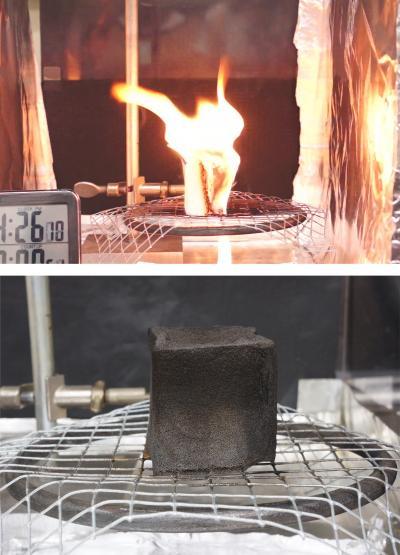In searching for better flame retardants for home furnishings—a large source of fuel in house fires—National Institute of Standards and Technology (NIST) researchers defied the conventional wisdom and literally hit a wall, one made of clay.
It wasn't a dead end, but rather a surprising result that may lead to a new generation of nonhalogenated, sustainable flame retardant technology for polyurethane foam. The thick, fast-forming coating that the NIST team created has a uniformly high concentration of flame-inhibiting clay particles, and it adheres strongly to the Swiss cheese-like surface of polyurethane foam, which is used in furniture cushions, carpet padding, children's car seats, and other items.
"In effect, we can build the equivalent of a flame-retarding clay wall on the foam in a way that has no adverse impact on the foam manufacturing process," explains NIST fire researcher Rick Davis. "Our clay-based coatings perform at least as well as commercial retardant approaches, and we think there's room for improvement. We hope this new approach provides industry with practical alternative flame retardants."
Davis and his NIST colleagues describe the new coating and the process they used to make it in the journal ACS Macro Letters.*
To date, researchers have built up coatings by stacking thin layers in pairs that are held together by basic electrical attraction. With no clay present, just a pure polymer, a thick coating is formed rapidly, but it isn't a fire retardant. With clay in every other layer, either the coating is too thin or the clay content is too low to be an effective fire retardant.

Using a testing device called a cone calorimeter, NIST researchers measure the heat-release rate and other flammability properties of materials. Above, untreated polyurethane foam catches fire from a nearby heat source. Below, foam treated with a novel clay-filled coating did not ignite when exposed to the same heat source. Instead, a fast-growing protective layer -- called char -- forms on the surface.
(Photo Credit: NIST)
The NIST team tried something you would expect not to work: trilayers consisting of a positively charged bottom topped by two negatively charged layers. Under most circumstances, the two negative layers would repulse each other, but it turns out that hydrogen bonds formed between the two negative layers and overcame this repulsive force.
The resulting trilayer yields a unique result: a thick, fast-forming, and high concentration clay coating on polyurethane foam. This nanocomposite coating is 10 times thicker, contains 6 times more clay, and achieves this using at least 5 times fewer total layers than the traditional bilayer coatings.
"The eight trilayer system thoroughly coated all internal and external surfaces of the porous polyurethane foam, creating a clay brick wall barrier that reduced foam flammability by as much as 17 percent of the peak heat release rate," the team reported. Only a few hundred nanometers thick, the final coating is transparent and the foam still has the same softness, support and feel.
Compared with amounts of current flame retardant applied to polyurethane foam, only half as much of the new clay-based coating was required to achieve comparable levels of performance.
Source: National Institute of Standards and Technology (NIST)